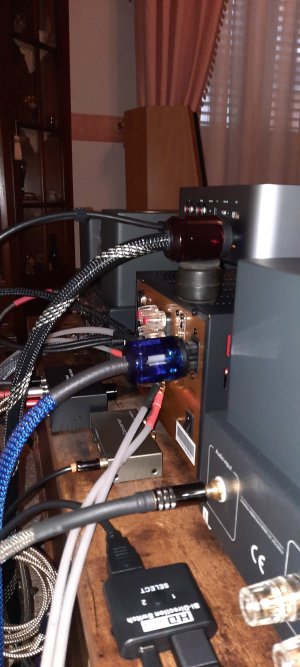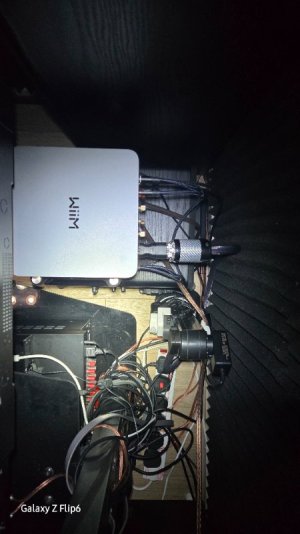Hmmm... Because the chassis provides the appropriate shielding?Yes. Have been reading about this audiophile power cord myth for more than 40 years.
Attached an example of the power connector for a $500 pre-amp and a $100 external power cable. If it did matter why then just these cheap wires in the amp?
You are using an out of date browser. It may not display this or other websites correctly.
You should upgrade or use an alternative browser.
You should upgrade or use an alternative browser.
Let's update power cable with something shielded
- Thread starter onlyoneme
- Start date
It’s clear that many here do not understand EMI/RFI and then go on with debased ad hominem attacks. What @onlyoneme is doing is worthwhile looking into. The point is not so much to filter noise going into Ultra but rather filter HF noise fed back by Ultra into the ac line. At a minimum it is a good idea to install ferrite loops on the Ultra ac line.
hgo58
Major Contributor
The low power audio components and the power cables are both inside the same chassis.Hmmm... Because the chassis provides the appropriate shielding?
The reason it doesn't matter is due to the distance between the components. The power line do generate noise close on but the level is below what is problematic a few centimeters away from it.
This may be an "audiophile" way of thinking, but it's really not very helpful. The electrical power is not simply handed down to the speakers. It doesn't carry any particular properties (like poison in a water pipe) that might make it the point of consumption. This is not an appropriate model of what is happening. It's just more complicated than that. Whatever a shielded power cord might or might not be able to suppress over an unshielded one has to evaluated individually. Even more so since the WiiM Ultra is a class 2 device so one potential way of RF entering the device (the safety ground) doesn't even exist. A shield can still be effective, even if it's connected at one end only. The idea of this thread is to test it out, not to know in advance what's going to happen.Power cords carry the voltages that becomes the signals that those cables all the way to your speakers.
Theory understood the right way (which is not the opposite of practice) is available to cover different views on this topic, for sure. All I'm asking is not to jump to conclusions without even evaluating which effects are predominant and which are not. So for now I just want to provide a couple of thoughts: High voltage goes through transformers with meaningful inductance when it is transformed to medium voltage and finally our low voltage grid. Concrete walls do block a certain amount of RF (otherwise WiFi signals would not be attenuated by them). A single open cable can well be a sending or receiving antenna.If noise can get into an electricity supply in the 1m between plug and device, then it's a reasonable, logical working conclusion to presume noise can get in to that supply before the plug.
This could be difficult to prove as fact, and I'm not going to be the one to suggest tapping into mains at the power station and again before it enters the fuse box.
But I think it'd be wrong to wave away that theory as 'just opinion', purely because it's not absolute proven fact.
We (or at least I) am not talking about 2 meters of snake oil cable magically transferring "dirty" into "clean" power. This is the kind of argument that I'd like to see not discussed here.
Admittedly, I had never heard of that brand name of that trend before. Either I didn't watch the scene closely enought during that period or it was more of a local phenomenon, I don't know.(ferrite coated industrial cable over their entire length... for sensitive environments etc.was a fashion in audio in my country at the beginning of the 2000s ;-) to be reserved for sources....
It doesn't matter? An internal cables management does matter as well as internal shielding whenever needed.The low power audio components and the power cables are both inside the same chassis.
The reason it doesn't matter is due to the distance between the components. The power line do generate noise close on but the level is below what is problematic a few centimeters away from it.
20ans deja...
This may be an "audiophile" way of thinking, but it's really not very helpful. The electrical power is not simply handed down to the speakers. It doesn't carry any particular properties (like poison in a water pipe) that might make it the point of consumption. This is not an appropriate model of what is happening. It's just more complicated than that. Whatever a shielded power cord might or might not be able to suppress over an unshielded one has to evaluated individually. Even more so since the WiiM Ultra is a class 2 device so one potential way of RF entering the device (the safety ground) doesn't even exist. A shield can still be effective, even if it's connected at one end only. The idea of this thread is to test it out, not to know in advance what's going to happen.
Theory understood the right way (which is not the opposite of practice) is available to cover different views on this topic, for sure. All I'm asking is not to jump to conclusions without even evaluating which effects are predominant and which are not. So for now I just want to provide a couple of thoughts: High voltage goes through transformers with meaningful inductance when it is transformed to medium voltage and finally our low voltage grid. Concrete walls do block a certain amount of RF (otherwise WiFi signals would not be attenuated by them). A single open cable can well be a sending or receiving antenna.
We (or at least I) am not talking about 2 meters of snake oil cable magically transferring "dirty" into "clean" power. This is the kind of argument that I'd like to see not discussed here.
Admittedly, I had never heard of that brand name of that trend before. Either I didn't watch the scene closely enought during that period or it was more of a local phenomenon, I don't know.

Eupen GNLM 3G2,5
Bulk cable Eupen Typ LP / GNLM 3G2,5 Audio Line Ferrit (EMC/COM), Cross-section 2,5 qmm, Outer Diameter 11,8mm
There is a lot of unwanted emotions here although reading my position once again here
 forum.wiimhome.com
forum.wiimhome.com
should be enough to cut off speculations.
Let's update power cable with something shielded
Why not, right? I found one sold on Amazon under the Tertullus brand (no, it's not Tellurium), it's cheap so suitable for the role ;) The resistance check for mains first. A stock one: A shielded one: Definitely better. Now something much more important - a test of shielding efficiency with...
should be enough to cut off speculations.
That's pretty cheap at least, even if it doesn't do anything, which would be the worst case. It surely cannot do any harm.
Eupen GNLM 3G2,5
Bulk cable Eupen Typ LP / GNLM 3G2,5 Audio Line Ferrit (EMC/COM), Cross-section 2,5 qmm, Outer Diameter 11,8mmwww.audioconnexion-shop.de
cooky560
Major Contributor
- Joined
- Jan 17, 2024
- Messages
- 560
We're all looking to make our items sound better, however with money not being an infinite resource, nor the rare earth materials required by some of products out there, I'd want to observe proof of a notable, audible improvement, as well as measurements before purchasing something power related.
We're all looking to make our items sound better, however with money not being an infinite resource, nor the rare earth materials required by some of products out there, I'd want to observe proof of a notable, audible improvement, as well as measurements before purchasing something power related.
Steve Woodhouse
Major Contributor
- Joined
- Aug 11, 2023
- Messages
- 2,002
[HUMOUR]There is one other option we've not considered.
If you believe the shielding on these power chord changes make a difference, then you could always remove the tinfoil hat you've made to save your head from 5G, etc., and fashion that into shielding for the cable. If it's enough to protect your brain from interference, it really should be good enough to protect your power supply.[/HUMOUR]
I'll get me coat...
If you believe the shielding on these power chord changes make a difference, then you could always remove the tinfoil hat you've made to save your head from 5G, etc., and fashion that into shielding for the cable. If it's enough to protect your brain from interference, it really should be good enough to protect your power supply.[/HUMOUR]
I'll get me coat...
Onlyoneme , what was the result ?Why not, right?
I found one sold on Amazon under the Tertullus brand (no, it's not Tellurium), it's cheap so suitable for the role
The resistance check for mains first.
A stock one:
View attachment 12777
A shielded one:
View attachment 12778
Definitely better.
Now something much more important - a test of shielding efficiency with the NCV sensor, which can detect the presence of AC voltage.
A stock one:
View attachment 12779
4 bars, the led is blinking all the time along with the buzzing.
And a shielded one:
View attachment 12780
Simply nothing, complete silence. Wow!
I want it nowBut...
It does not fit when USB port is also used...
View attachment 12781
I will have to use an adapter for C7/C14, someone mentioned it already on the forum.
To be continued...
The USB adaptor is a great idea, thanks!I published this alternative solution with a USB adaptor to adapt the network connecter to the other cable topic:
View attachment 12812
You need to use Wi-Fi as I haven't found a small enough Ethernet connecter yet.
It's a shame that the topics that deal with these things are often the subject of comments from users who only make jokes about them.
It would be nice to be able to discuss it on a technical level...
Did you put something under the plug? The cable was too inclined, I was afraid of ruining the contacts.
Attachments
Last edited by a moderator:
dangermouse
Senior Member
- Joined
- Jul 25, 2023
- Messages
- 337
It would be nice to be able to discuss it on a technical level...
Agreed...providing that the technical level discussion makes sense.
mattultrahifi
Member
Why not, right?
I found one sold on Amazon under the Tertullus brand (no, it's not Tellurium), it's cheap so suitable for the role
The resistance check for mains first.
A stock one:
View attachment 12777
A shielded one:
View attachment 12778
Definitely better.
Now something much more important - a test of shielding efficiency with the NCV sensor, which can detect the presence of AC voltage.
A stock one:
View attachment 12779
4 bars, the led is blinking all the time along with the buzzing.
And a shielded one:
View attachment 12780
Simply nothing, complete silence. Wow!
I want it nowBut...
It does not fit when USB port is also used...
View attachment 12781
I will have to use an adapter for C7/C14, someone mentioned it already on the forum.
To be continued...
Attachments
Fletcher Munson
Member
- Joined
- Nov 7, 2025
- Messages
- 72
nuts
Similar threads
- Replies
- 31
- Views
- 2K


